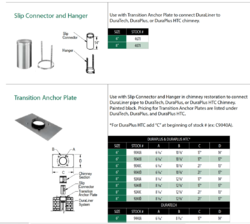Hey guys.
New to the Hearth.
Background: I'm adding a MF NOVA stove to my existing masonry fireplace. I've ran a chimney liner. There is not enough room for insulation wrap, so I am just going to pour Vermiculite for insulation -- (I'm in Michigan, near Lake Michigan..it gets cold here, so I am thinking I'll definitely need it).
Since my existing chimney was built way before the 10' & 2' codes, I also have to extend my pipe above the ridge of the house. I am looking at the Class A double walled stuff. For example, I am leaning towards 48" piece since it will get me above the minimum of where I need to be and also do the job of helping with draft. I am looking at the Shasta
However, I cannot seem to find any information about how to connect the chimney liner to the rigid outdoor pipe.
I guess I am looking for a transition plate, for example this
Has anyone any info on this? Has anyone also installed something similar?
My concern is that I purchase all of this and it ends up having the same inside diameter as the flex liner, in which case how do I hook the flex liner to the class A stuff?
Any help would be appreciated.
New to the Hearth.
Background: I'm adding a MF NOVA stove to my existing masonry fireplace. I've ran a chimney liner. There is not enough room for insulation wrap, so I am just going to pour Vermiculite for insulation -- (I'm in Michigan, near Lake Michigan..it gets cold here, so I am thinking I'll definitely need it).
Since my existing chimney was built way before the 10' & 2' codes, I also have to extend my pipe above the ridge of the house. I am looking at the Class A double walled stuff. For example, I am leaning towards 48" piece since it will get me above the minimum of where I need to be and also do the job of helping with draft. I am looking at the Shasta
However, I cannot seem to find any information about how to connect the chimney liner to the rigid outdoor pipe.
I guess I am looking for a transition plate, for example this
Has anyone any info on this? Has anyone also installed something similar?
My concern is that I purchase all of this and it ends up having the same inside diameter as the flex liner, in which case how do I hook the flex liner to the class A stuff?
Any help would be appreciated.
Last edited:


